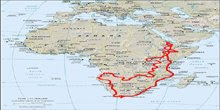After our trek in the Bale Mountains, we spent a few days to relaxing at Wim’s Holland House in Addis Ababa. We took full advantage of the wonderful cafés selling fresh fruit juices, pastries and Ethiopian coffee before setting off on a circuit of northern Ethiopia. First stop: the famous rock-hewn churches of Lalibela.

Coffee Shop in Addis
The road to Lalibela via Weldiya is under construction and passes through picturesque highland farms before it drops dramatically down the escarpment. The first 200km north of Addis are particularly dusty and potholed with many heavy slow moving vehicles. It took us two full days from Addis with a stop over in Karakore. Petrol (benzeen) becomes more scarce (expensive and poor quality) once you leave the main road north, so it is worth filling up in Weldiya before tackling the long steep climb up to Gashena. Diesel is more widely available en route and in Lalibela.
 Highland landscape
Highland landscapeThe day before we left Addis, we had the opportunity to attend a lecture on the history of the Lalibela churches by some French archaeologists (at the Alliance Française). We learned that the churches had been built by the 11th century AD. The details on who built the churches and when, their purpose and the construction method are not known for sure and will be the subject of a EU funded research programme due to start later this year. Indeed, there is a lot of legend and speculation surrounding these monuments. We had also started reading “The Sign and the Seal” by Graham Hancock, who adds to the intrigue by suggesting that the Knights Templar may have been involved in their construction and linking it the search for the lost Ark of the Covenant ….
Whatever the true history might be, we really enjoyed exploring the hidden passages and chambers on our own, imagining different histories for these amazing living monuments.

















 Local boys giving us a football lesson
Local boys giving us a football lesson




No comments:
Post a Comment